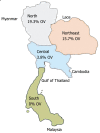Opisthorchis viverrini: the carcinogenic human liver fluke
- PMID: 18205254
- PMCID: PMC2683991
- DOI: 10.3748/wjg.14.666
Opisthorchis viverrini: the carcinogenic human liver fluke
Abstract
Opisthorchiasis caused by Opisthorchis viverrini remains a major public health problem in many parts of Southeast Asia, including Thailand, Lao PDR, Vietnam and Cambodia. The infection is associated with a number of hepatobiliary diseases, including cholangitis, obstructive jaundice, hepatomegaly, cholecystitis and cholelithiasis. Multi-factorial etiology of cholangiocarcinoma, mechanical damage, parasite secretions, and immunopathology may enhance cholangiocarcinogenesis. Moreover, both experimental and epidemiological evidences strongly implicate liver fluke infection as the major risk factor in cholangiocarcinoma, cancer of the bile ducts. The liver fluke infection is induced by eating raw or uncooked fish products that is the tradition and popular in the northeastern and northern region, particularly in rural areas, of Thailand. The health education programs to prevent and control opisthorchiasis are still required in the high-risk areas.
Figures





Similar articles
-
Opisthorchiasis in Thailand: review and current status.World J Gastroenterol. 2008 Apr 21;14(15):2297-302. doi: 10.3748/wjg.14.2297. World J Gastroenterol. 2008. PMID: 18416453 Free PMC article. Review.
-
Current status of human liver fluke infections in the Greater Mekong Subregion.Acta Trop. 2021 Dec;224:106133. doi: 10.1016/j.actatropica.2021.106133. Epub 2021 Sep 10. Acta Trop. 2021. PMID: 34509453 Review.
-
Pathobiology of opisthorchiasis: an update.Acta Trop. 2003 Nov;88(3):209-20. doi: 10.1016/j.actatropica.2003.08.002. Acta Trop. 2003. PMID: 14611875 Review.
-
[Control of Opisthorchis viverrini infection for cholangiocarcinoma prevention].Bull Soc Pathol Exot. 2017 Feb;110(1):61-67. doi: 10.1007/s13149-017-0544-8. Epub 2017 Jan 19. Bull Soc Pathol Exot. 2017. PMID: 28105582 Review. French.
-
Opisthorchiasis and Opisthorchis-associated cholangiocarcinoma in Thailand and Laos.Acta Trop. 2011 Sep;120 Suppl 1(Suppl 1):S158-68. doi: 10.1016/j.actatropica.2010.07.006. Epub 2010 Jul 23. Acta Trop. 2011. PMID: 20655862 Free PMC article. Review.
Cited by
-
Epithelial-Mesenchymal Transition in Liver Fluke-Induced Cholangiocarcinoma.Cancers (Basel). 2021 Feb 14;13(4):791. doi: 10.3390/cancers13040791. Cancers (Basel). 2021. PMID: 33672838 Free PMC article. Review.
-
An Insight into Cholangiocarcinoma and Recent Advances in its Treatment.J Gastrointest Cancer. 2023 Mar;54(1):213-226. doi: 10.1007/s12029-021-00728-5. Epub 2022 Jan 13. J Gastrointest Cancer. 2023. PMID: 35023010 Review.
-
Pathogens and Carcinogenesis: A Review.Biology (Basel). 2021 Jun 15;10(6):533. doi: 10.3390/biology10060533. Biology (Basel). 2021. PMID: 34203649 Free PMC article. Review.
-
Species-specific renal and liver responses during infection with food-borne trematodes Opisthorchis felineus, Opisthorchis viverrini, or Clonorchis sinensis.PLoS One. 2024 Dec 5;19(12):e0311481. doi: 10.1371/journal.pone.0311481. eCollection 2024. PLoS One. 2024. PMID: 39637122 Free PMC article.
-
The Microbiome and Metabolic Dysfunction-Associated Steatotic Liver Disease.Int J Mol Sci. 2025 Mar 22;26(7):2882. doi: 10.3390/ijms26072882. Int J Mol Sci. 2025. PMID: 40243472 Free PMC article. Review.
References
-
- Leiper RT. Notes of the occurrence of parasites presumably rare in man. J London School Trop Med. 1911;1:16–19.
-
- Kerr AFG. Intestinal parasites in northern Siam. Trans Soc Trop Med. 1916;9:82–89.
-
- Prommas C. Report of case of Opisthorchis felineus in Siam. Ann Trop Med Parasitol. 1927;21:9–10.
-
- Sadun EH. Studies on Opisthorchis viverrini in Thailand. Am J Hyg. 1955;62:81–115. - PubMed
Publication types
MeSH terms
LinkOut - more resources
Full Text Sources
Medical

